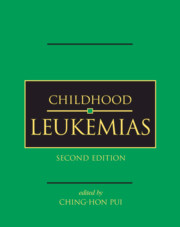Book contents
- Frontmatter
- Contents
- List of contributors
- Preface
- Part I History and general issues
- Part II Cell biology and pathobiology
- 4 Anatomy and physiology of hematopoiesis
- 5 Hematopoietic growth factors
- 6 Signal transduction in the regulation of hematopoiesis
- 7 Immunophenotyping
- 8 Immunoglobulin and T-cell receptor gene rearrangements
- 9 Cytogenetics of acute leukemias
- 10 Molecular genetics of acute lymphoblastic leukemia
- 11 Molecular genetics of acute myeloid leukemia
- 12 Apoptosis and chemoresistance
- 13 Heritable predispositions to childhood hematologic malignancies
- Part III Evaluation and treatment
- Part IV Complications and supportive care
- Index
- Plate Section between pages 400 and 401
- References
10 - Molecular genetics of acute lymphoblastic leukemia
from Part II - Cell biology and pathobiology
Published online by Cambridge University Press: 01 July 2010
- Frontmatter
- Contents
- List of contributors
- Preface
- Part I History and general issues
- Part II Cell biology and pathobiology
- 4 Anatomy and physiology of hematopoiesis
- 5 Hematopoietic growth factors
- 6 Signal transduction in the regulation of hematopoiesis
- 7 Immunophenotyping
- 8 Immunoglobulin and T-cell receptor gene rearrangements
- 9 Cytogenetics of acute leukemias
- 10 Molecular genetics of acute lymphoblastic leukemia
- 11 Molecular genetics of acute myeloid leukemia
- 12 Apoptosis and chemoresistance
- 13 Heritable predispositions to childhood hematologic malignancies
- Part III Evaluation and treatment
- Part IV Complications and supportive care
- Index
- Plate Section between pages 400 and 401
- References
Summary
Introduction
Although most cases of acute lymphoblastic leukemia (ALL) do not arise from a recognized predisposing genetic condition, this disease is still considered to have a genetic basis. That is, somatically acquired genetic changes contribute in pivotal ways to the genesis of ALL and have important implications for its diagnosis and treatment. Such acquired lesions, restricted to the leukemic clone, include alterations in both the number (ploidy) and structure of the blast cell chromosomes, the latter consisting of reciprocal translocations, inversions, deletions, gene amplifications, and point mutations. Although many of these abnormalities can be detected by routine cytogenetic analysis, others require molecular assays. Molecular identification of the genetic targets of these alterations has led to the isolation and characterization of numerous oncogenes and tumor suppressors, providing valuable clues to the mechanisms of leukemogenesis. In this chapter, we review the molecular basis of childhood ALL, emphasizing the oncogenes, oncoproteins, and tumor suppressors that appear to be critical components of a limited number of transforming pathways.
Proto-oncogene activation
Standard karyotyping can identify chromosomal translocations, including both recurrent and random rearrangements, in about 50% of cases of childhood ALL. When molecular assays are used with cytogenetic analysis, evidence of a translocation is seen in about 70% of cases (Fig. 10.1). Translocations in ALL most often disrupt genes that encode transcription factors (Tables 10.1 and 10.2), defined as nuclear proteins that bind to DNA and regulate the expression of other cellular proteins.
- Type
- Chapter
- Information
- Childhood Leukemias , pp. 272 - 297Publisher: Cambridge University PressPrint publication year: 2006



